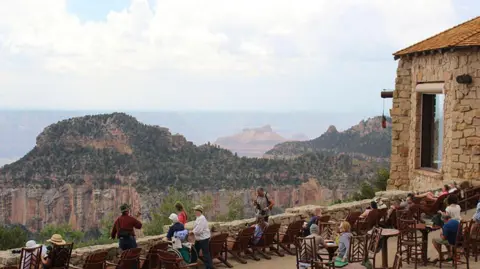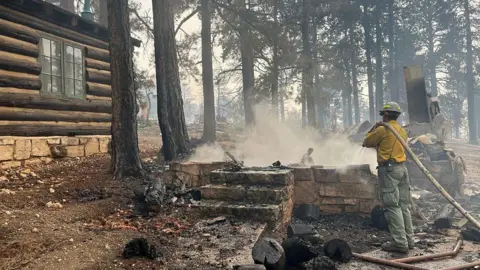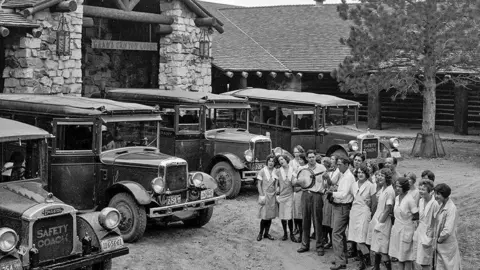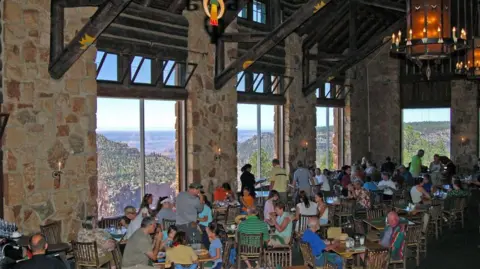'Heart-breaking': Locals and visitors devastated by loss of Grand Canyon Lodge
 Getty Images
Getty ImagesDavy Crockett watched from miles away as the first small plumes of smoke began to rise in the Grand Canyon's North Rim.
It was not long before the small plumes transformed into huge flames. Mr Crockett, vice-president of the non-profit Grand Canyon Historical Society, went to bed but worries kept him up. The historic Grand Canyon Lodge, with its panoramic views of one of the natural wonders of the world, was in the path of those flames.
On Sunday, park officials confirmed the beloved lodge was destroyed in raging wildfires.
"It broke my heart," said Mr Crockett. "I was devastated."
Hundreds of people are sharing his sadness and posting tributes on social media to the stone lodge perched at 8,000 feet (2,438m), the only accommodation available within the national park's North Rim.
It was "stunning, a balm for my weary soul", one person wrote. "Heartbroken to hear the historic lodge, visitor center and more were destroyed."
 Getty Images
Getty ImagesMany of the dozens of cabins at the lodge were also lost in the Dragon Bravo Fire, which has burned over 5,000 acres.
Honeymooners, hikers and runners all treasured the lodge and its views, historians and locals said.
Karne Snickers has led tours in the North Rim for 24 years. She said the area sees fewer tourists than the South Rim because the view in parts is slightly obscured by "majestic" ponderosa trees.
But it was clear on the deck of the Grand Canyon Lodge, she said.
"It's very spiritual there," she said. "Sitting on the deck of that lodge, there isn't one dry eye from any trip that I've ever done when you turn away and have to go back to the van."
The destruction of the lodge has been like "losing an old friend".
"I shed many tears yesterday," Ms Snickers said.
The 61-year-old tour guide was there just before the fires began, when a lightning strike ignited a blaze on 4 July that officials initially thought would be containable.
But after the winds picked up, the fire exploded, Mr Crockett said.
Firefighters were there to protect the lodge, but when a water treatment plant burned down and released toxic chlorine gas into the air, they had to evacuate.
Along with the lodge, much of the surrounding nature has been lost too, including 400 year-old trees.
Ms Snickers believes one large tree she would have hikers on her tours hug is no longer there.
"Much of the beauty is gone," Mr Crockett said. "It'll take decades for things to grow back."
 National Park Service
National Park ServiceThis was the second time the lodge burned down.
A version that opened in 1928, designed by architect Gilbert Stanley Underwood, was lost four years later to a fire that started in its kitchen.
Building a new structure during the Great Depression took years and perseverance, repurposing much of the original building's stonework and lumber.
A smaller, temporary lodge that housed construction workers also burned down for unknown reasons, according to Mr Crockett.
Then, a massive snowstorm dropped 12 feet of snow in the area one winter, cutting the workers and their families off from food and the outside world for weeks, he said.
Finally, some of the workers hiked down to the trailhead in snow shoes to call for help, bringing in snow plows to rescue the rest of the group, Mr Crockett said.
After the lodge opened once again, in 1938, it became a "summer getaway that people have just cherished over the years", he said.
Lodge guests might encounter an occasional buffalo while walking beside tall pine trees. Inside, they could take in views from the massive windows in the lodge's sun room, or from their table in the dining room, with its high ceiling that was crossed with ponderosa beams.
Park officials have yet to say whether they plan to rebuild the iconic lodge, but many visitors and locals are holding out hope.
"We have to rebuild this place," Ms Snickers said. "It's going to take time, but it needs to come back. It was a part of history."
 National Park Service
National Park Service